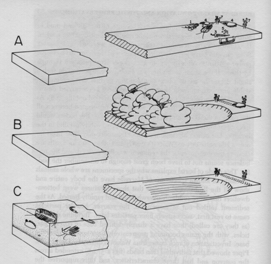The Preservation of the Burgess Shale
The exceptional preservation of fossil material found within the Burgess Shale is the most significant feature of this deposit. Before discussing the processes which resulted in this unique deposition, it is necessary to understand the nature of the environment where these organisms lived. The presence of an algal reef indicates that depths were relatively shallow, well oxygenated, and well lit. In such an environment, preservation potential would normally be less than perfect. The fauna in this environment would not only be exposed to scavenging by other organisms, but would also be susceptible to rapid decay. However, the place where the fossil organisms found in the Burgess Shale lived was much different from where, following transport, preservation occurred.

Following periodic mud slumps Burgess Shale organisms were transported downslope and deposited into anoxic waters (see right photo). In this anoxic environment, the amount of decay was limited and very slow. Predator and scavenger damage was also not a factor here. Under these conditions in conjunction with the compaction of overlying mud, the soft parts of the organisms were preserved as thin carbon films interspersed with fine mud layers. The excellent preservation of these softer tissues as well as hard skeletal parts is what makes the deposit so unique.
Fortunate protection from tectonism during the Mesozoic era has also influenced the preservation potential of the fossils. During this time, the Mount Wapta and Mount Field area, along with the Stephen Formation and the Burgess Shale, were moved along a thrust fault and brought to their present site. The fossils remained protected here from pressures and heats of surrounding tectonic events.
Fossils of the Burgess Shale
Table of contents
